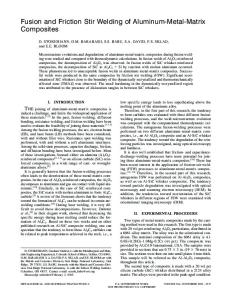High Speed Joining of Aluminum Metal Matrix Composites Using Continuous Wave and Pulsed Lasers
- PDF / 360,050 Bytes
- 6 Pages / 416.88 x 635.4 pts Page_size
- 105 Downloads / 336 Views
HIGH SPEED JOINING OF ALUMINUM METAL MATRIX COMPOSITES USING CONTINUOUS WAVE AND PULSED LASERS PARWAIZ A. A. KHAN AND ANAND J. PAUL Concurrent Technologies Corporation, 1450 Scalp Avenue, Johnstown, PA 15904
ABSTRACT Due to their superior mechanical properties and high strength to weight ratio, metal matrix composite materials are increasingly being used in aerospace, automotive and defense industries. The use of a fusion related conventional joining technique, such as arc welding, leads to the formation of undesirable non-equilibrium phases in the weld zone, where as diffusion and adhesive joining techniques are rather slow. Non contact multi-kilowatt laser joining, though fully developed for high speed autogenous joining of different alloys, is not yet adequate for joining of metal matrix composites. Efforts have been made by several researchers to control the composition and microstructure of laser joined aluminum metal matrix composites by controlling the energy input and by the use of filler wires. In view of the current industry trend to use more light weight structural composite materials, and greater use of high energy density beams for a variety of metalworking applications, the authors have reviewed the current status of high speed laser joining of metal matrix composites. Emphasis is placed on problems and various techniques which can be used to achieve a better control on composition and microstructure during high energy laser joining of aluminum metal matrix composites.
INTRODUCTION The ever growing demand for new high performance materials to be used in highly specialized applications spurred the development of new engineering materials. Composite materials were developed because no single, homogeneous structural material could be found that had all of the desired properties for a given application 11,2]. Various stiffer and stronger reinforcements such as particulates, continuous and discontinuous fibers or laminates when added to a relatively weak matrix form a composite material whose properties are superior to that of the matrix. Depending upon the type of the matrix, composites are divided into polymer and metal matrix. Metal matrix composites consist of a metal base that is reinforced with one or more constituents, such as continuous graphite, alumina, silicon carbide, or boron fibers and discontinuous graphite or ceramic materials in particulate or whisker from. When compared with polymer composites, metal matrix composites offer certain advantages, such as, high tensile and shear moduli (which are compatible with those of the fibers), high melting point, small thermal expansion coefficient, resistance to moisture, dimensional stability, joinability, high ductility and toughness. Some of the important applications of metal matrix composites include, mid fuselage, landing gear drag link of space shuttle, neutron shielding, aircraft, missiles, engines, bridging, pressure vessels, projectile fins, drive shafts, tubes, reinforced pistons and missile wings [3]. The structures made of composites ar
Data Loading...











